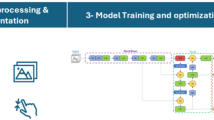Abstract
Water surfaces are polluted due to various man-made and natural pollutants. In urban areas, natural water sources including rivers, lakes and creeks are the biggest collectors of such contaminants. Monitoring of water sources can help to investigate many of details relating to the types of litter and their origin. Usually two principle methods are applied for this type of applications, which include either a use of in-situ sensors or monitoring by computer vision methods. Sensory approach can detect detailed properties of a water including salinity and chemical composition. Whereas, a camera based detection helps to monitor visible substances like floating or immersed objects in a transparent water. Current computer vision systems require an application specific computational models to address a variability introduced due to the environmental fluctuations. Hence, a computer vision algorithm is proposed to detect and classify floating objects in various environmental irregularities. This method uses an evolutionary algorithmic principles to learn inconsistencies in the patterns by using a historical data of river pollution. A proof of the concept is built and validated using a real life data of pollutants. The experimental results clearly indicate the advantages of proposed scheme over the other benchmark methods used for addressing the similar problem.
Access this chapter
Tax calculation will be finalised at checkout
Purchases are for personal use only
Similar content being viewed by others
References
Sikder, M.T., Kihara, Y., Yasuda, M., Yustiawati, Mihara, Y., Tanaka, S., Odgerel, D., Mijiddorj, B., Syawal, S.M., Hosokawa, T., Saito, T., Kurasaki, M.: River water pollution in developed and developing countries: judge and assessment of physicochemical characteristics and selected dissolved metal concentration. Clean Soil Air Water 41(1), 60–68 (2013). doi:10.1002/clen.201100320
Hart, J.K., Martinez, K.: Environmental sensor networks: a revolution in the earth system science? Earth-Sci. Rev. 78(3–4), 177–191 (2006). doi:10.1016/j.earscirev.2006.05.001
Jacobs, N., Burgin, W., Fridrich, N.: The global network of outdoor webcams: properties and applications. In: Proceedings of the 17th ACM SIGSPATIAL International Conference on Advances in Geographic Information Systems, GIS’09, pp. 111–120 (2009), doi:10.1145/1653771.1653789l
Fingas, M.F., Brown, C.E.: Review of oil spill remote sensing. Spill Sci. Technol. Bull. 4(4), 199–208 (1997)
Plotnik, A.M., Rock, S.M.: Quantification of cyclic motion of marine animals from computer vision. In: OCEANS’02MTS/IEEE, vol. 3, pp. 1575–1581 (2002), doi:10.1109/OCEANS.2002.1191870
Ferri, F.J., Pudil, P., Hatef, M., Kittler, J.: Comparative study of techniques for large-scale feature selection. Mach. Intell. Pattern Recognit. 16, 403–413 (1994)
Yang, J., Honavar, V.: Feature subset selection using a genetic algorithm. Feature Extraction, Construction and Selection. Springer, New York (1998)
Oliveira, L.S., Benahmed, N., Sabourin, R., Bortolozzi, F., Suen, C.Y.: Feature subset selection using genetic algorithms for handwritten digit recognition. In: IEEE Proceedings of XIV Brazilian Symposium on Computer Graphics and Image Processing, pp. 362–369 (2001)
Pernkopf, F., O’Leary, P.: Feature selection for classification using genetic algorithms with a novel encoding. Computer Analysis of Images and Patterns. Springer, Berlin (2001)
Sun, Z., Bebis, G., Miller, R.: Object detection using feature subset selection. Pattern Recognit. 37(11), 2165–2176 (2004)
Oh, I.-S., Lee, J.-S., Moon, B.-R.: Hybrid genetic algorithms for feature selection. IEEE Trans. Pattern Anal. Mach. Intell. 26(11), 1424–1437 (2004)
Lin, T.C., Liu, R.S., Chen, S.Y., LiU, C.C., Chen, C.Y.: Genetic algorithms and silhouette measures applied to microarray data classification. In: APBC, pp. 229–238 (2005)
Zhu, F., Guan, S.: Feature selection for modular GA-based classification. Appl. Soft Comput. 4(4), 381–393 (2004)
Lac, H.C., Stacey D.A.: Feature subset selection via multi-objective genetic algorithm. In: IEEE International Joint Conference on Neural Networks, vol. 3 (2005)
Zhuo, L., Zheng, J., Li, X., Wang, F., Ai, B., Qian, J.: A genetic algorithm based wrapper feature selection method for classification of hyperspectral images using support vector machine. In: Geoinformatics 2008 and Joint Conference on GIS and Built Environment: Classification of Remote Sensing Images, pp. 71471J–71471J. International Society for Optics and Photonics (2008)
Jurie, F., Schmid, C.: Scale-invariant shape features for recognition of object categories. In: Proceedings of the 2004 IEEE Computer Society Conference on Computer Vision and Pattern Recognition, vol. 2 (2004)
Xiaolong, D., Khorram, S.: A feature-based image registration algorithm using improved chain-code representation combined with invariant moments. IEEE Trans. Geosci. Remote Sens. 37(5), 2351–2362 (1999)
Campbell, C.: Kernel methods: a survey of current techniques. Neurocomputing 48(1), 63–84 (2002)
Koza, J.R.: Survey of genetic algorithms and genetic programming. In: WESCON/’95, Conference Record, Microelectronics Communications Technology Producing Quality Products Mobile and Portable Power Emerging Technologies, p. 589 (1995)
Zhang, J., Marszalek, M., Lazebnik, S., Schmid, C.: Local features and kernels for classification of texture and object categories: a comprehensive study. Int. J. Comput. Vis. 73(2), 213–238 (2007)
Kenji, K., Rendell, L.A.: A practical approach to feature selection. In: Proceedings of the Ninth International Workshop on Machine Learning. Morgan Kaufmann Publishers Inc. (1992)
Kale, A., Chaczko, Z.: Supervised feature classification for pollution monitoring on river water surface. In: 2nd Asia-Pacific Conference on Computer Aided System Engineering—APCASE (2014)
Author information
Authors and Affiliations
Corresponding author
Editor information
Editors and Affiliations
Rights and permissions
Copyright information
© 2015 Springer International Publishing Switzerland
About this chapter
Cite this chapter
Kale, A., Chaczko, Z. (2015). Evolutionary Feature Optimization and Classification for Monitoring Floating Objects. In: Borowik, G., Chaczko, Z., Jacak, W., Łuba, T. (eds) Computational Intelligence and Efficiency in Engineering Systems. Studies in Computational Intelligence, vol 595. Springer, Cham. https://doi.org/10.1007/978-3-319-15720-7_1
Download citation
DOI: https://doi.org/10.1007/978-3-319-15720-7_1
Published:
Publisher Name: Springer, Cham
Print ISBN: 978-3-319-15719-1
Online ISBN: 978-3-319-15720-7
eBook Packages: EngineeringEngineering (R0)




